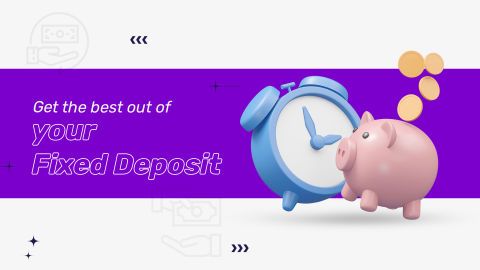Where should you invest your money?
Depending on your risk appetite, you can choose to invest in either market-linked instruments or those that remains unaffected by the market movements. Market-linked investments yield higher returns, but these are not always the best investment plans as they risk losing your capital. In comparison, investment tools like fixed deposits offer more security of funds. Bajaj Finance is one such financier that provides the dual benefit of high FD rates and safety of funds.
How to start investing
Here is a quick guide on how you can start investing:
1. Define your goal
Determine what you are saving for (retirement, down payment, etc.) and your desired timeframe.
2. Research
Research different investment options, their risks and potential returns. This can involve reading articles, watching videos, reading balance sheets or consulting a financial advisor.
3. Diversify
Begin with a manageable amount and spread your investments across different asset classes (stocks, bonds, real estate) to mitigate risk.
4. Review
Regularly review your portfolio and adjust your investments as needed to align with your goals and market conditions.
How does the risk appetite affect your investment choices?
Most investments carry a certain level of volatility, and usually, the returns on an investment are more when the levels of risk are high. Thus, investment decisions are often taken based on investors' risk appetite.
1. Low-risk investments
Fixed-income instruments include bonds, debentures, fixed deposit schemes, and government Savings Schemes.
2. Medium-risk investments
Debt funds, balanced mutual funds fall in this category.
3. High-risk investments
Volatile investments include instruments like stocks and equity mutual funds.
Factors for choosing the investment plan?
1. Investment goal
It is essential to identify your investment goals - whether it is long-term wealth building, to fund education or marriage expenses, or for short-term financial goals.
2. Risk tolerance
The level of risk that you are willing to take on, which differs based on your age, financial position, and investment goal, must be factored in.
3. Investment Horizon
It is crucial to determine the length of the investment period, and how it aligns with your financial goals.
4. Tax considerations
Investments can be taxed at different rates, based on the investment duration and type.
5. Investment cost
Fees and charges levied by the investment option, such as brokerage fees, administration fees, exit fees, and fund expenses, must be considered before investing.
Benefits of investment plans
Investment plans offer a multitude of benefits for individuals seeking to grow their wealth and secure their financial future. These plans provide a structured approach to investing, allowing you to achieve your financial goals over time while enjoying various advantages. Here are some of the key benefits of investment plans:
1. Goal-based planning
Investment plans enable you to set specific financial goals, whether it's saving for retirement, buying a home, funding your child's education, or starting a business. By creating a structured plan, you can tailor your investments to meet those goals within a defined timeframe.
2. Wealth creation
Investment plans offer the potential for substantial wealth creation over time. By investing in various assets like stocks, bonds, or mutual funds, you can benefit from market growth and compound interest, significantly increasing your net worth in the long run.
3. Inflation protection
One of the most significant advantages of investment plans is their potential to outpace inflation. Inflation erodes the purchasing power of money over time, but by investing in assets that can grow at a rate higher than inflation, you can protect your savings and maintain their real value.
4. Tax benefits
Certain investment plans, such as Public Provident Fund (PPF), Unit Linked Insurance Plans (ULIPs), Equity Linked Savings Scheme (ELSS), and Sukanya Samriddhi Yojana (SSY), offer tax-saving benefits under sections 80C and 10(10D) of the Income Tax Act. These deductions can significantly reduce your taxable income, thereby lowering your overall tax liability.
5. Regular income
Some investment plans, particularly those that invest in dividend-paying stocks or bonds, can provide a regular income stream. This is especially beneficial for retirees or individuals seeking a steady income source.
6. Expert management
Many financial plans are managed by professional fund managers with expertise in analyzing market trends and identifying opportunities. This can be especially beneficial for individuals who lack the time or knowledge to oversee their investment actively.
Why are long-term investments important?
Long-term investments come with several benefits. They typically offer higher returns compared to short-term options, as your money has more time to grow. Staying invested over an extended period also helps smooth out market fluctuations, reducing the impact of short-term volatility.
These investments are well-suited for major financial goals such as your child’s education or wedding, purchasing a home, or retirement planning. They allow you to build wealth gradually while also offering certain tax^ benefits, all without disrupting your current financial commitments or lifestyle.
That said, it’s important to evaluate each long-term investment carefully. Make sure you understand the associated risks before committing your funds.
Conclusion
Investing is more than just setting money aside — it's about using it strategically to help it grow over time. While there is always some risk involved, investing remains one of the most effective ways to save for major life goals, such as buying a dream home or securing a comfortable retirement.











